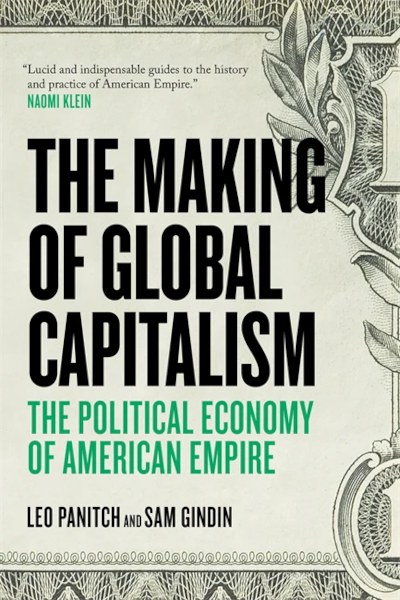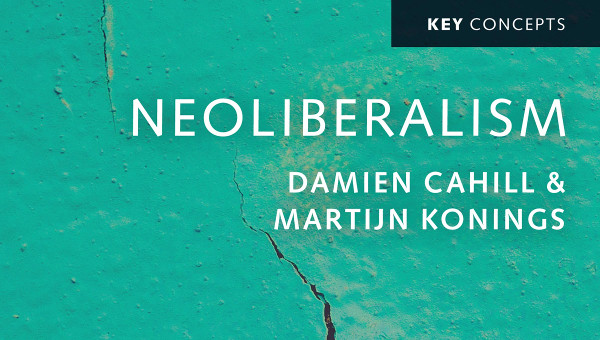Bidenomics and the Left
“There’s something happening here
But what it is ain’t exactly clear.”
– “For What It’s Worth,” Buffalo Springfield.
The Other Crisis
The go-to crises of the socialist left have been “American declinism” and “inter-imperial rivalry.” These crises have not only been predicted by the left but often wished for, the left seeing them as doing much of the heavy lifting it cannot do on its own. This is both bad analysis and worse politics. It overstates declinism, wrongly projects the (very real) tensions between the US and China into a contest over who will lead global capitalism, and assumes that things getting worse inherently advances progressive politics.
The US is not – apart from China – facing any definitive decline relative to its main economic competitors. Nor is it facing a profit squeeze; corporate profits have been running at their highest ever share of GDP (see chart below), and non-financial profits per unit of real output were 74% higher in 2022 than in 2006 (i.e., before the 2008-9 financial crisis). As for the relationship with China, economic competition has indeed intensified, but the mutual dependence of the US and China block the kind of rivalry that shaped left thinking a century ago. The challenge – for both countries – is how to manage the militarization of technology without undermining the broader free trade and capital flows that characterize the present global order each are so dependent on.
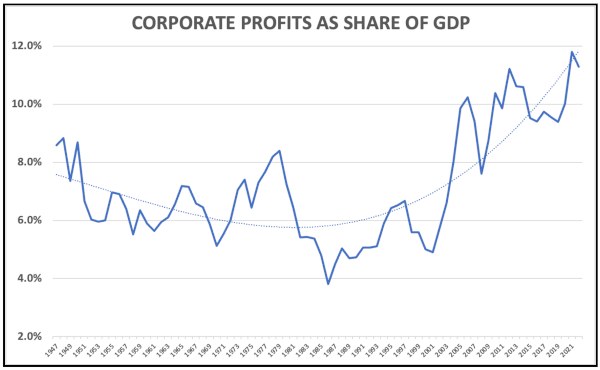
Crisis-mongering as politics is ill-conceived because expecting a weak labour movement to be strengthened by a deep economic crisis or geopolitical conflict is at best paradoxical. As we’ve repeatedly witnessed, the very weakness of US labour leaves US capital and the US state with the time and space to develop responses to crises and do so largely on the backs of workers.
More generally, in the absence of a left capable of carrying forth a convincing alternative, warnings of imminent economic decline are as likely to lower expectation and solicit conservative as progressive reactions. In the face of new uncertainties, workers in the relatively developed countries may, and often do, see the pre-crisis period they formerly condemned in a more favourable light. Restraints and concessions that promise a return to the previous status quo may seem more promising than calls to risk pushing radically ahead.
Similarly, growing tensions between states do not axiomatically strengthen popular forces. Inter-imperial conflict may just as readily facilitate the integration of workers’ organizations into a domestic cross-class nationalist alliance in which worker representatives are the decidedly junior partner. Or, as we’ve seen, it could heighten nationalism in its most negative sense and open doors to the extreme right.
The singular focus on the usual suspects of declinism and geopolitical rivalry is not only misplaced but tends to neglect a different kind of crisis, one commonly discounted because it seems ethereal and less expressly political: a crisis of social legitimation. Significantly, this crisis is not the result of US economic failures but of its successes in enforcing the deeper subordination of workers’ lives and of communities to capitalism’s narrow ends, a process often summarized as “neoliberalism.” The consequent decades-long build-up of working-class frustrations brought on a pervasive spirit of social decay, faded hopes, and political polarization. In its wake came widespread alienation from public institutions, ranging across the judicial system, the police, the media, the power of big business, unresponsive political parties, dysfunctional government, and reaching liberal democracy itself.
This crisis is distinct not only in its content (social, not economic; domestic, not international) but in its form. The protagonist isn’t a coherent, organized social force challenging America’s self-image as the “shining city on the hill” but something at best embryonic, with no clearly articulated expression or meaningful institutional presence and open to mobilization on the right as well as the left. For decades the state has comfortably held this festering crisis in check. Yet in spite of its inchoate form, it seems now to be generating a palpable nervousness within the highest levels of the American state.
Imperial Power Begins at Home
In a 2020 interview, Jake Sullivan, Biden’s current National Security Advisor and a geopolitical hawk, noted his shock in coming to see “how profoundly such a large segment of our country felt their government wasn’t working for them.” More recently, Janet Yellen, the US Secretary of the Treasurer, warned that this disquieting trend is threatening to undermine the “credibility at home” so critical to America’s “credibility abroad.” There is no shortage of explanations for America’s credibility problem abroad, but what Yellen and Sullivan were highlighting was the increased threat social failures at home posed to the reproduction of the empire internationally.
Sullivan, speaking a week after Yellen on Bidenomics, self-consciously noted his turn from geopolitics to domestic concerns. He justified this by referencing Biden’s core commitment to “more deeply integrate domestic policy and foreign policy.” This, as Sullivan had emphasized in the earlier interview, demands a special sensitivity to “the strength of US foreign policy and national security [lying] primarily in a thriving American middle class.” (“Middle class,” for those uncomfortable with acknowledging that the US is a class society, is code for “working class.”)
In stressing the imperial importance of having “a thriving American middle class,” Sullivan insists, in language many progressives will cheer, that legitimacy on the home front demands a radical reversal in the neoliberal consensus that has long united Republicans and Democrats (including administrations he and Biden were part of). Sullivan’s critique begins with an attack on the presumption that “markets always allocate capital productively and efficiently.” Notably, even some prominent Republicans, like Florida Senator Marco Rubio, have edged onto this terrain, inveighing against the “twenty-five-year orthodoxy in the Republican Party centered around market fundamentalism.”
Sullivan moves on to challenge the related priority of quantitative growth over its quality. Greater attention to quality would give more weight to the impact of economic activity on the environment, take into account how the growth is shared, and distinguish between more investment in general and that in strategic sectors. Along the same lines, free trade should put workers ahead of consumers, and strong state initiatives are vital. Central here is the need for a “modern industrial strategy” unashamedly state-led though implemented by private corporations. This is not a key official representative of the Biden administration going rogue. Greg Ip, the Wall Street Journal’s Chief Economic Advisor, branded Sullivan’s speech as “the most definitive statement to date of Bidenomics.”
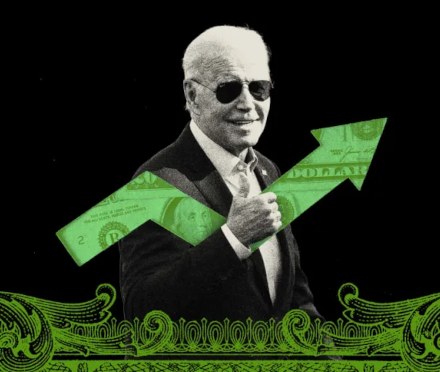
Both Yellen and Sullivan raise the issue of competitiveness, a concern inherent to all capitalist states but of special interest to the imperial state. There is, however, no hint here of any special panic over the relative performance of the US. Yellen dismissively notes that “pronouncements of US decline have been around for decades [but] they have always been proven wrong.” She goes on to confidently assert that the US “has repeatedly demonstrated its ability to adapt and reinvent to face new challenges. This time will be no different – and the economic statistics show why.”
China, on the other hand, does pose a greater urgency to economic competitiveness. Yet though resolute, the tenor of Yellen and Sullivan here too include a degree of restraint. The US, they believe, can ultimately address the non-militarized competition with China by way of Biden’s active industrial strategy. But going further to isolate China as an inter-imperial rival or to dream of regime change is limited by sober realities. The kind of economic “containment” that was applied to the Soviet Union in the post-war years cannot be contemplated against a country that stands so predominantly inside the American-led empire. Given their mutual economic interdependence, any US “decoupling” from China would, Yellen warned, be “disastrous.” William J. Burns, the head of the CIA, has since echoed that response, calling decoupling “foolish.”
Yet economic co-existence is one thing; absolute US military power to guarantee that the global order is unambiguously US-led, is another. In America’s self-appointed responsibility to oversee the rule of law in the making of global capitalism, the American state does not see itself as a state like other states. Rather, it reserves a special sovereignty for itself that licences it to bend the rules as needed to preserve the US as the “indispensable nation.” In the US’s eyes, China’s advances in militarized high tech, aided by its access to global (including US) technologies, threaten America’s military dominance.
China is indeed determined to achieve both a degree of autonomy within the American empire and a respect and status commensurate with its growing global economic weight. But it has no interest in nor the economic, financial, administrative, and military capacities for replacing the US as the overseer of the capitalist world order.
Since excluding China from the global economy is neither in the US’s interests nor possible, the alternative is to carve out from free trade those trade and capital flows that carry militarized potentials. In her diplomatic trip to China to calm tensions, Yellen declared that the world is “big enough for the US and China.” The unstated subtext was “even if new restrictions on trade and capital flows are coming.” (Interestingly, given the war in Ukraine, Sullivan and Yellen pay virtually no attention to Russia in their geopolitical commentaries.)
Because the lines between the production of the most strategic semiconductors and commercial ones are blurred, managing this distinction between commercial and military flows will not be easy. This race cannot avoid the disruption of global supply chains and increased costs. As well, alarm bells are already going off in Europe – allies whom the US will need in this contest – over a loss of valuable markets if China responds. Europe is further worried that the US will use militarized “exceptions” to override free trade rules to the US’s own economic advantage. And of course, whatever the immediate negative effects of technological restraints on China, the prospects of China successfully accelerating its drive to match the US can hardly be discounted, all the more so since this contest includes not just research and development but manufacturing capabilities.
Adding to the anxiety over China’s rapid advance in high tech comes the nervousness over “credibility at home.” The laments Sullivan and others utter for the suffering of working people are above all driven by the underlying imperial implications of America’s deep social malaise: the possibility that alienation at home may throw up barriers to the American state’s actions abroad. Might, for example, a Trump-like mobilization of popular resentment against free trade again resurface, next time more seriously? Might unmet needs at home challenge the diversion of vast wealth to costly military interventions abroad (such as in Ukraine or in dealing with China)? Will the justifications for spreading prosperity and democracy abroad clash with the reality of similar gaps within the US?
In Sullivan’s articulation of Bidenomics, there is a sophistry that extends beyond bemoaning the conditions of America’s “middle class.” Criticizing “excess” dependence on markets serves to legitimate “normal” dependence on markets and their related property rights. Defending a role for government initiatives portrays the state as inherently good, without addressing what the intervention is for. Calling for a “modern industrial strategy” upholds the priority of competitiveness – especially of the militarized high-tech kind with China – over other values. Limiting China’s development is a crucial policy driver but it comes with no serious questioning of why the US is, and must always remain, singularly dominant.
The key slight-of-hand here lies in characterizing Bidenomics as a foil to “neoliberalism” by obscuring what neoliberalism actually is. Unpacking neoliberalism’s essence and its relationship to capitalism and the American empire is therefore critical to any evaluation of Bidenomics.
Neoliberalism: Markets, States and Class Power
Markets and states are not in opposition but have a symbiotic (mutually dependent) relationship that is shaped by underlying structures of class power. Markets need states as much as states depend on markets and the private corporations that work through markets. Certain functions, especially ones related to the expanded reproduction of capitalism as a totality, cannot be provided by private capitalists who are divided into competing units and focused on their own profit-maximization.
Such essential capacities have instead been developed over time within the state and include the creation of the domestic environment for both domestic and multinational corporations to prosper not only via the roads, rail, airports, utilities, and land development they provide – all long acknowledged – but also through the protection of corporate property rights and the provision of a pliable labour force.
In the first decades after WWII, a perfect storm led to the so-called “welfare state.” Pressures from working families who had lived through the deprivations of the Depression and war-time sacrifices, alongside corporations made flush by the post-war economic boom, set the stage for delivering significant working-class gains. Crucially however, these gains did not fundamentally challenge the basic power structures of capitalism; they were instead embedded in the larger project of constructing and legitimating a new kind of empire. The gains were consequently contingent and vulnerable, as events proved.
When the post-war boom faded in the late sixties, what followed was a decade-long profitability crunch, an acceleration of inflation, and threats to the international role of the dollar. It took the American state nearly a decade to develop an effective response, the core of which was to prioritize accumulation/profits over popular needs by way of deepening capitalist disciplining structures. After a significant amount of working-class resistance – but without labour having any larger plan or capacity to democratize investment – the state imposed higher unemployment. This exhausted workers’ defiance and exposed the labour movement’s political weaknesses.
The result was the imposition of the long-lasting neoliberal curse that the labour movement is still suffering from today. Adolph Reed pithily captured the essence of that affliction as essentially “capitalism without a working-class opposition.” The past forty-five years or so decisively remade the working class to better fit capitalism’s changing requirements. This happened both directly through the state and indirectly via the state’s role in industrial restructuring (in the public sector, even when departments were not privatized, they came to be managed so as to more closely emulate operating standards set in the private sector). The working class as a social category became an individualized, survival-driven, exhausted, and fractured non-class with lowered expectations and hopes, a fatalistic view of societal alternatives, a cramped and increasingly cynical view of democracy, and to a disturbing (if media-exaggerated) extent open to populist demagogues.
Over time the dispiriting social symptoms that came with this form of capitalism piled up. Precarious work was normalized, well-paying jobs became scarcer. Working families worked longer hours than at any time since WWII; work was relentlessly intensified; parents worked through vacations to offset rising tuition costs; sons and daughters stayed at home longer. Rural areas were depopulated; suicide rates rose among young people; the horrors of school shootings continued. The unresolved opioid crisis accounted for 70,000 deaths annually (100,000 adding other drug deaths). The US spent more on health than any other country and yet saw the worst outcomes, including the distinction, rare in the “rich world,” of a fall in life expectancy.
This historic defeat of the working class, it is worth repeating, came by way of markets and active, not passive, states. Seeing neoliberalism in terms of “less state” and its rebuttal lying in “more state” obscured the class content of state actions: “what kind of state, doing what, to whom and for whom, and with what impact on structures of class power?” Getting this right is fundamental to seeing through the Sullivan/Biden paradigm for American renewal.
Some important state functions were indeed restrained over this period, in particular the growth in social programs. But the critical point – against popular (mis)conceptions – is that other state activities have expanded. A short list of the latter would include not only military purchases but the size of police forces, the number of prisons, free trade bureaucracies, financial regulators; commercial research at public universities, corporate subsidies, and state interventions in “disruptive” strikes on the side of the employer.
Going further, the extent of the expansion of global trade could not have occurred without the free trade agreements hammered out by states and which states administer and enforce. Liberalized finance brought a greater role for financial markets, but out of practical necessity, this came with far more complex state-established rules to manage the volatility of those markets. And when those rules proved inadequate, only states had the capacity to restore order and, in the process, save capitalism itself.
At sectoral levels, high tech entrepreneurs would not have achieved their market successes without the start-up research and subsidies provided by the state via military expenditures and state-run or state-subsidized labs. Pharmaceutical companies depend on patents enforced by the state to limit generic alternatives and their threat of lower prices. Airlines depend on publicly owned and regulated airports.
Neoliberalism was, in short, a radical project to renew American capital domestically and globally. Out of capitalist necessity, doing so came at the expense of the working class. Reversing this implied not more state but “a different kind of state,” one with a radically different relationship to the economy and class power. This, not the size of the state, is the criterion by which Bidenomics must be assessed.
Bidenomics: Antidote to Neoliberalism?
Biden the politician and Sullivan the representative of the deep state overlap in rhetorically distancing themselves from the decades when so many American citizens “felt their government wasn’t working for them.” For Biden, the driver is reestablishing the Democratic Party’s credibility in the face of its repeated domestic betrayals. For Sullivan, the driver is legitimating the American state so as to limit populist challenges to America’s imperial role and its domestic burdens. Both express sympathy to the needs of working people, but those remain subordinate to the reproduction of the basic power structures and direction of American capitalism.
Biden shifted from Trump’s “Make America Great Again,” with its direct criticism of recent Dem administrations, to the safer “Keep America Great.” He committed to revive the labour movement through supporting unionization, creating decent-paying jobs, improving social programs, fixing collapsing infrastructure, and addressing the environmental crisis. Whatever regulations this required, the end was nevertheless conditional on strengthening US capital, not weakening it. And in Sullivan’s case, his prime focus on limiting China’s advance translated his dictum favouring “quality” growth into growth that put militarized tech capacities ahead of all else.
The outcome was an ideological reframing of America’s trajectory to reflect a sensitivity to popular frustrations, but its concrete practices were far too shallow to cope with the scale of the problems faced by the majority of Americans. This timidity has been most transparent in Biden’s special emphasis on reviving unionization. When Biden came into office in 2021, union density was just over 10%, less than half what it was when neoliberalism emerged (itself already one third below its mid-1950s peak). In spite of Biden’s public endorsements of unions and regulatory and administrative changes, union density hasn’t budged; if anything, it fell lightly.
Biden spoke out in favour of unions and made positive administrative and regulatory changes, but where was an updated Roosevelt-like break to catalyze union advance? What happened to the “card check” Biden once supported? Why isn’t any interference by employers in what are workers’ decisions treated as “foreign intervention” and banned?
This would include the inherently anti-union captive meetings, and it could be enforced not through ineffective fines, but with automatic certification. Moreover, why isn’t it workers, rather than the companies, who can call periodic on-sight paid meetings to collectively discuss their conditions? And why wouldn’t this be extended to the right to invite union representatives on site to talk union during these meetings? And why as well aren’t union organizers given contact lists of workers – if it’s good enough for political elections, why not when the issue is democratic workplace representation?
The reliance of Bidenomics on corporate incentives to address industrial strategy, the massive infrastructural chasm, and “fixing” the environment contrasted with the imposition of an agreement on striking rail workers. It also ignored the learned experience that keeping corporations and the rich happy was a central cause for the ever-growing class inequalities and the implicit diversion of resources from social programs that Biden was allegedly grappling with.
In the case of industrial renewal, this seems at first blush to have been a remarkable success, with construction expenditures in manufacturing “going parabolic” in Paul Krugman’s phrase. Yet the concentration of incentives on the manufacture of the highest tech semiconductors did little for jobs in the hard-hit Midwest. And since the higher interest rates had a negative impact on the rest of the economy, what was being overlooked by liberals was that total non-residential investment is actually now no higher than the trend line before the subsidies (see graph below). The results are equally unimpressive if we look at overall non-residential investment as a share of GDP.
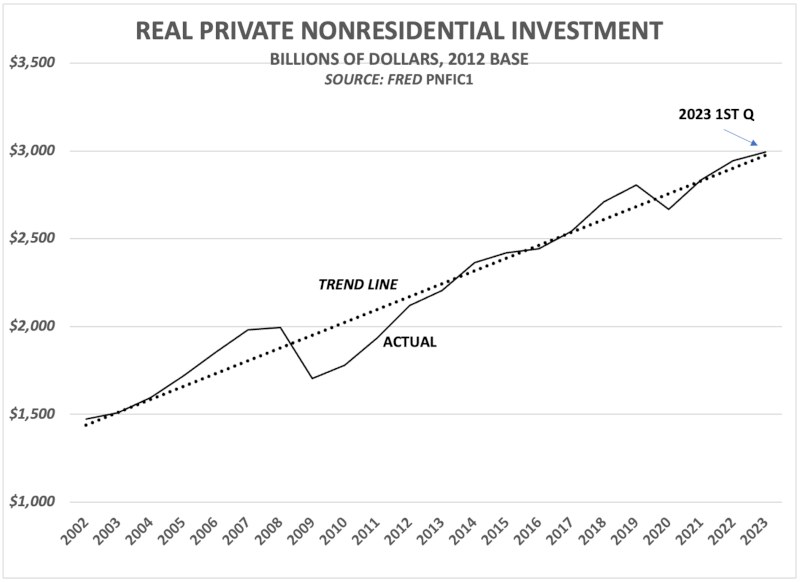
As for infrastructure, given the extent of the gaps in the US and the massive construction projects needed, why hand this over to private contractors instead of creating a government-run construction unit, a public utility developing in-house planning and implementing capacities with democratic input? This flows into the Biden’s tepid response to the environment. Acknowledging the seriousness of the environmental crisis may, after Trump, have been refreshing, as was a positive rash of regulations. But specific retreats soon had environmentalists “reeling from Biden’s moves to boost fossil fuels” while industry expressed confidence in Biden’s “pragmatism.”
The massive subsidies to support the electrification of vehicles – itself a positive step but much overstated as a solution to the looming environmental crisis – was Biden’s alternative to mandating this rather than bribing private corporations to do what has become socially critical. During WWII, the production of cars was banned from 1941 to war’s end in the name of confronting the existential challenge at the time. The environmental crisis is no less of an existential threat and a permanent one to boot.
More generally, fragmented corporations driven by maximizing their private profits are no base for addressing the environmental crisis. Biden’s overall environmental agenda, with its dependence on “incentivizing” corporations, was on the wrong track for matching the scale of the threat. As Steve Maher and Scott Aquanno have noted:
“Any green transition will require the state to mobilize the productive capacities currently owned and controlled by private corporations based on a public plan for allocating investment … Instead of being given subsidies and contracts, firms that are critical for the “greening” of the economy should be nationalized – which, in turn, raises the question of how to democratically organize these economic activities … Clearly, [a transformed] state is the only social structure capable of carrying out such a transition.”1
There were other tests for concretely assessing the extent of the Biden turn. If the richest country in the world couldn’t provide its citizens with the universal health care common in the developed countries, could it really be expected to lead the fight for a healthy environment? And engaging workers in the struggle to address the environment demanded putting substance into the promise of a “just transition.” Might worker scepticism been overcome if the emphasis on infrastructure and industrial reconstruction was integrated with a convincing plan for the systematic economic conversion of everything about how we work, consume, travel and live?2
Ditto the relative passivity in tax policy. The stunning increases in inequality over the past decades invited a no less dramatic increase in taxes on the rich but no populist drive came from the Dems to at least move the US back towards its pre-neoliberal standards (hardly beyond the pale since even that level of inequality was widely criticized at the time). And when the US Fed and most economists were arguing that excess demand was a critical factor in the recent inflation, why wasn’t this an opportune moment to raise “equality of sacrifice” through an emergency wealth tax to soak up the “excess demands” of the rich in particular? Instead of a pool of funds for future social programs workers experienced a decline in their purchasing power since Biden was inaugurated. Instead of wages making inroads into corporate profits, between January 2021 to June 2023 (latest data) hourly wages after inflation fell by over 3%.
Yes, Biden is no doubt better than the “other guy.” Yes, the Republicans (and even some Democrats) have undermined Biden’s intentions. Yes, some of Biden’s changes matter. And yes, the unions themselves bear a share of the blame in stagnating union density. But what could be more emblematic of the Reagan-like nexus of market, state, and militarism than Bidenomics offering corporations the carrot while avoiding the stick and prioritizing militarized productive capacities rather than social ones?
Bidenomics is in significant part a response to the inchoate and threatening unease that came with the radical restructuring of American society since the end of the 1970s. This is distinct from responding to coherent and organized collective pressure from below, and this provides cause for being wary about how far Bidenomics would or could go in terms of progressive change. Bidenomics is too small, too tied in with corporate interests, too timid to initiate an educational and organizational crusade to achieve its promises. Marcetic and Markovčič and French rightly emphasize the willful blindness in seeing Bidenomics as a fundamental counter to neoliberalism.
Conclusion: Polarizations
The inequalities in the US raised above theoretically provided political space for income redistribution and gains in social programs. But the systematic consolidation and strengthening of capitalism over those years meant that substantive gains could only be made and sustained by equally substantive acts of undoing. The power and reach that American industry and finance had accumulated over the years had to be taken on. The policy options were polarized: moderate tweaks that left the status quo basically intact or an alternative vision that demanded a fundamental policy challenge to corporate structures of power.
Some see this “polarization of options” as too bleak and point to a new development in capitalism that creates a powerful liberal ally. Against the conservative anti-inflation bias of banks, Asset Management Funds (AMFs) with their stunning growth counter this by prioritizing the volume of assets, reinforcing support for economic stimulus and growth. As well, the universal reach of these funds inclines it to support the interventionist policies of a “modern industrial strategy” and internalizing financial measures of the environmental, social, and governance costs of corporate practices. (Brian Deese, a former exec at BlackRock – the largest of the AMFs – was working on precisely such issues before becoming an influential Biden advisor.)
All this elides the capitalist air these financial giants still breathe, the competitive waters they still win in and the fire of profits still in their bellies. Facing an “excess” inflation that threatens the value of their assets and worker militancy that adds unwelcome uncertainty, these funds have lined loyally up with the rest of capital. While they might integrate certain environmental and other social costs into their calculations, they ultimately oppose – like all corporations – moves that may undermine their power and their bottom lines.3
The social base for change therefore continues to rest with labour and the social movements. The scale of organizing this base must not be underestimated. What makes this all the harder is the depth of the defeat of unions. And what makes it still harder is the social malaise among the general population. After the lived experiences of the past forty plus years with their betrayals and lost confidence in unions and politics, how to “make the dead man rise again” (Ernst Bloch)?
Yet the clearer it is that reconstructing our lives, approaching our individual and collective potentials, and preserving the environment require a corresponding consideration of truly radical policies, the clearer it is that imagining alternative policies is not enough. Meaningful policy alternatives demand a corresponding alternative politics. This presents a second polarization: electoral politics or a redefinition of politics based on building a coherent, confident social base with the vision, understandings, and strategic acumen to ultimately transform society.
This is not a matter of rejecting electoral politics – winning a majority of citizens to radical change through democratic means is fundamental. But coming to governance without a solid social base while the powerful centrifugal influences of capitalism remain in place leads to the disappointments we and others abroad have repeatedly experienced. Without the ability to monitor, check, support, and pressure governments to stay the course, government promises fade. Elections alone become largely irrelevant. Participation in elections may have a tactical role in reaching people, but building the base for social transformation is what is so overwhelmingly central today. Only that will make elections truly relevant down the road.
The “how” of building that social base was always a hard question. It is all the more difficult today when the crisis of record is not the contradictions of capitalism but the crisis on the left. Capitalism’s defeat and remaking of working-class life through those years of defeat leaves us near the starting gate in the project of radical class formation.
Over the past quarter century, a hopeful trajectory seemed on its way. Protests, single-issue campaigns over status within the status quo, and demands that were primarily defensive moved on to a promising recognition of the need to confront universal issues and explicitly address the state. When this too disappointed, activist energy moved on – again promisingly – to workplaces and the struggle for unionization.
Yet all this proved ever so thin. At its core, a throughline was the search for quick fixes and not, for all the enthusiasm, the patient and creative construction of the needed edifice. An example is the current overriding emphasis on union density. This is obviously a necessary dimension of building class power, but it needs to be put into perspective. Canada currently has two-and-a-half times the unionization rate of the US, something American activists look at with wide-eyed envy. Yet the Canadian labour movement is no more dynamic and in many cases less so than its US counterpart.
What the emphasis on density and numbers of union members blanks out is the need for a different kind of unionism, one that brings class back in not just as ideology, but as a practical necessity in a struggle that extends beyond the workplace. So too is it a practical necessity that workers come to understand the full scale of the enemy they are fighting – the capitalist system, not just its manifestation in their own employer – and incorporate that reality into their education and strategies/tactics.
Nor is the issue how to link unions to movements, though of course that too matters. For one, social “movements” in the US and Canada have gotten a free ride in left assessments. Relative to unions, they generally have neither the membership base, the daily presence in the life of their members, the institutional resources and financial independence, or in a good many cases even the democratic structures that unions, for all their flaws, have. There are certainly sporadic movement eruptions and occasionally they reach a national scale, but they have proven to have limited organizing substance and lasting power. Combining movements barely able to reproduce themselves with currently relatively ineffective unions offers no answer to challenging capitalism. Transforming each is a condition for bringing both constructively together. And this is likely only through the intervention a working-class institutional form beyond specific unions and movements (and extending far beyond electoralist politics).
The central problem on the left is above all organizational. It is so difficult not only because of the weaknesses of the left’s existing institutions but because of the more general social malaise enveloping working people. Though workers will always resist out of the basic will to survive, daily life does not encourage hope, and existing structures do not inspire confidence that participating in them can facilitate larger changes. Addressing this demoralizing anomie is the left’s greatest failing and most fundamental challenge.
The choice is not between localized busy-ness of coping with immediate problems or placing our sights on the largest of scales. The local is a necessary part of all organizing but must be located within the ambit of the larger context. This places on the agenda the need for a special kind of working-class institution: one with the ambition and capacity to act as a counter to the capitalist state, something of a shadow state in intent, though of course still lacking the resources needed for social transformation.
This capacity to accumulate strengths, pass on memories and organizing skills, serve as a space for debate and re-evaluation for spreading democratic understandings and building the coherence, collective capacities, and confidence to confront capitalism is the precondition for serious socials change. Such a working-class institution – a socialist party – is distinct in that while having one foot in existing institutions and struggles, the other foot stands with the project of ending capitalism and taking state power to the end of transforming the state from top to bottom, to then end of it acting as an instrument for the democratic transformation of work and community.
The above may be self-evident to socialists, but even then there is a polarization – a third polarization – over when to make the jump to a socialist party (or parties). Waiting for the right time to form a socialist party will likely mean waiting forever. History can’t be comfortably counted on to convey the “right time.” Creating a socialist party is a voluntarist act, one taken in defiance of history’s apparent trajectory.
This is not a matter of ignoring material realities but of refusing to accept their limits. It is a matter of soberly struggling with current conditions and immediate needs while strategically linking them to a world that seems impossible at the moment. It is a collective act of revolutionary imagination, stubborn defiance, and strategic creativity. •
This article was written in May 2023, and first published on the Nonsite website.
Endnotes
- Scott Aquanno and Stephen Maher The Fall and Rise of American Finance: From JP Morgan to BlackRock (London: Verso, 2023), 224, 226.
- See, for example, Saule Omarov, The Climate Case for a National Investment Authority (Data for Progress, 2020).
- For an exceptionally sharp analysis of the economics and politics of these funds, see Aquanno and Maher, Fall and Rise of American Finance.


